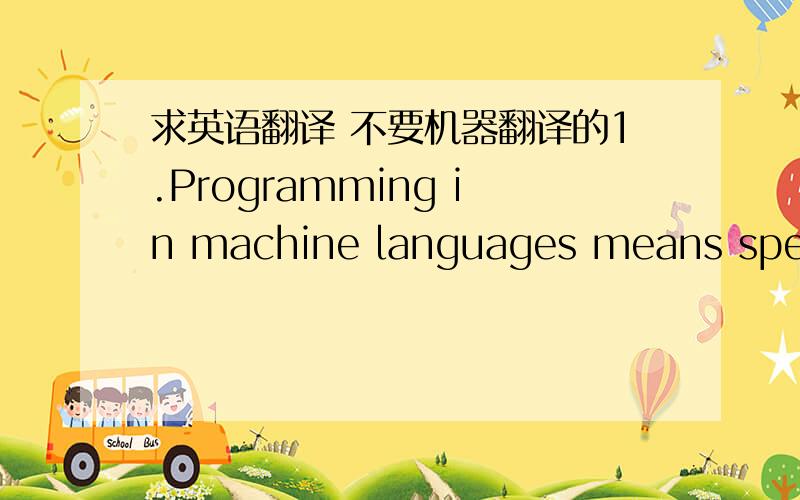求英语翻译 不要机器翻译的1.Programming in machine languages means speaking directly to the computer in the language of 1s and 0s it understands. Machine language is the fastest because no translation is required on the computer’s part.
来源:学生作业帮助网 编辑:作业帮 时间:2024/05/23 20:24:45

求英语翻译 不要机器翻译的1.Programming in machine languages means speaking directly to the computer in the language of 1s and 0s it understands. Machine language is the fastest because no translation is required on the computer’s part.
求英语翻译 不要机器翻译的
1.Programming in machine languages means speaking directly to the computer in the language of 1s and 0s it understands. Machine language is the fastest because no translation is required on the computer’s part. However, it is almost impossible to learn-imagine having to enter a string(字符串) of hundreds of binary digits just to tell the computer to perform a basic operation like adding numbers. Nevertheless, this is how the first generation(代) computers were programmed.
2. Operating systems have developed over the past thirty years for two main purposes. First, they provide a convenient environment for the development and execution of programs. Second, operating systems attempt to schedule computational activities to ensure good performance of the computing system. The operating system must ensure correct operation of the computer system. To prevent user programs from interfering with the proper operation of the system, the hardware was modified to create two modes: user mode and monitor mode.
3. The input/output and secondary(辅助) storage units are sometimes called peripheral devices (or just peripherals). This terminology refers to the fact that although these devices are not a part of the CPU, they are often located near it. Besides, a computer system also includes buses, ROM (read only memory), RAM (random access memory), parallel(并行) port and serial(串行) port, hard disk, floppies and CD (computer disk) drive, and so on.
4. Output Devices Like input units, output devices are instruments of interpretation and communication between humans and computer systems of all sizes. These devices take output results from the CPU in machine-coded form and convert them into a form that can be used (a) by people (e.g., a printed and/or displayed report) or (b) as machine input in another processing cycle.
5. The operating system must ensure correct operation of the computer system. To prevent user programs from interfering with the proper operation of the system, the hardware was modified to create two modes: user mode and monitor mode. Various instructions (such as I/O instructions and halt instructions) are privileged and can only be executed in monitor mode. The memory in which the monitor resides must also be protected from modification by the user. A timer prevents infinite loops. Once these changes (dual mode, privileged instructions, memory protection, timer interrupt) have been made to the basic computer architecture, it is possible to write a correct operating system.
6. In personal computer systems, display screen and desktop printers are popular output devices. Larger and faster printers, many online workstations, and magnetic tape drives are commonly found in larger systems.
求英语翻译 不要机器翻译的1.Programming in machine languages means speaking directly to the computer in the language of 1s and 0s it understands. Machine language is the fastest because no translation is required on the computer’s part.
以下是我的翻译,不知道楼主是为了自己理解还是会整理成书面材料,所以在翻译是碰到由此而地方提供了两种结果,共楼主参考,如果是个人理解,那么基本可以满足,若是整理材料,可能有些专业术语还需要再次核对.希望我的回答可以帮到你.
1.要对机器进行语言编程就意味着:直接用机器可以明白的1和0这样的语言.这是最有效的(最快的)方式.因为这种方式在电脑部分内部不需要再次翻译.但是,想要通过给机器输入成百上千的数据(/字符串)就可以让它完成一个基本的手术,就像是添加一个数据一样的简单,几乎是不可能的.然而,这也正是第一代电脑编程产生的原因.(/然而,也正是这个想法催生了第一代电脑编程)
2.在过去的30中,操作系统的发展主要是为了以下两个主要目的.首先:它为程序的发展和执行提供一个方便的环境(/便捷的途径).其次,操作系统尝试着去安排电脑的行动步骤.(/操着系统尝试着为电脑提供一个适合的行动流程)以确保电脑系统的运作达到最好的状态.操作系统必须确保可以更正电脑系统的运行.为了阻止用户编程干扰计算机系统的正确运行,于是把硬件改成了两种模式:用户型和检测型.
3.输入,输出和辅助存储设备(单元/部分)通常被叫做外部设备.这个术语(外部设备)是表明这些设备不属于CPU(/不是CPU的组成部分).它们通常放置在CPU的旁边.除此之外,电脑系统还包括:路径,只读,改写,并行,串行,硬盘,软盘,磁盘驱动器等.
4.输出设备,和输入单元一样.输出设备是人们和各种电脑系统进行交流沟通的工具,这些设备从CUP中提取出结果再把它转化成a.人们可以阅读的形式(打印或者显示出一份报告)b.或者输入机器进行下一个循环.(此句话的意思是,举个例子吧:从电脑上下载歌曲,再转存进walk man 中,这样就是walk man 输出给人可以用的信息了)
5.这一段前面的内容第二段后面不是有一半了吗,相同的我就不翻译了,直接从不一样的开始:各种各样的指令(比如I/O,暂停)等都是有优先权的,而且只能在检测模型中用到.同时留存在检测系统中的记忆也是被保护的-防止用户修改.一个计时器可以防止无止尽的循环.一旦这些变化(双重模式,特权指令,记忆保护,计时器控制)可以运用到电脑的基本构造中,那么编写一个正确的手术操作系统就会成为可能.
6.在个人电脑系统中,屏幕播放和便携打印 都是很流行的输出方式,更大更快的打印机,许多在线的工作站,以及磁带驱动器,这些都组成了一个更大的系统.
人工翻译,同上有一些专有名词不一定准确,和楼上的翻译有些不同,你可以都参考看看,希望对你有帮助
1.机器语言的编程意味着直接用电脑懂得的由1和0组成的语言和电脑对话。机器语言是与电脑对话最快的语言因为计算机能够直接“理解”而不需要“翻译”。但是,这种语言却很难被学会。想象一下每次你要计算机执行一个基本的任务如做加法,你都需要输入一串几百个二进制的数字来发出指令。然而,这就是第一代计算机的编...
全部展开
人工翻译,同上有一些专有名词不一定准确,和楼上的翻译有些不同,你可以都参考看看,希望对你有帮助
1.机器语言的编程意味着直接用电脑懂得的由1和0组成的语言和电脑对话。机器语言是与电脑对话最快的语言因为计算机能够直接“理解”而不需要“翻译”。但是,这种语言却很难被学会。想象一下每次你要计算机执行一个基本的任务如做加法,你都需要输入一串几百个二进制的数字来发出指令。然而,这就是第一代计算机的编程方式。
2.操作系统近三十年来因为两个主要目的在发展。首先,他们为程序的发展和使用提供了一个方便快捷的方式。第二,操作系统试图通过调度各种电脑活动来保证电脑系统良好的运行。操作系统一定要能够保证电脑系统的正常运行。为了避免用户程序和系统运行的冲突,硬件被分成了两种模式:用户模式和监控模式。
3.输入、输出以及辅助储蓄单位有时被成为周边装置(或者就叫周边)。这个技术名词意味着虽然这些装置不是电脑的中央处理器(CPU)的一部分,但是,他们一般位于其旁边。此外,一个电脑系统一般包括总线,只读存储器(ROM),随机存取存贮器(RAM),并行端口和穿行端口,硬盘,软盘以及光驱(CD drive),等等。
4.输出装置,如输入单位一样,输出装置包括了不同大小的用以帮助人和电脑沟通交流的器件。这些装置从CPU中取得以机器代码的形式显示的输出结果,然后把这些结果转成(a)人们可以使用(如一个打印的或可以展示的一份报告)或者(b)另一个循环处理循环的机器输入。
5.操作系统一定要能够保证电脑系统的正常运行。为了避免用户程序和系统运行的冲突,硬件被分成了两种模式:用户模式和监控模式。各种指令(如1、0的指示以及中断的指示)被升级成了只有监控模式下才可以使用。一个计时器就可以防止无止尽的循环。一旦这些改变(双模式,升级的指令,记忆保护,计时器控制)被做成电脑的基本结构,一种良好的系统运行可以被编程出来。
6.在个人电脑系统中,显示屏和桌面打印机是最常见的输出装置。更大更快的打印机,很多的在线工作站,以及磁带机则只能在更大的运行系统里才能找到。
收起